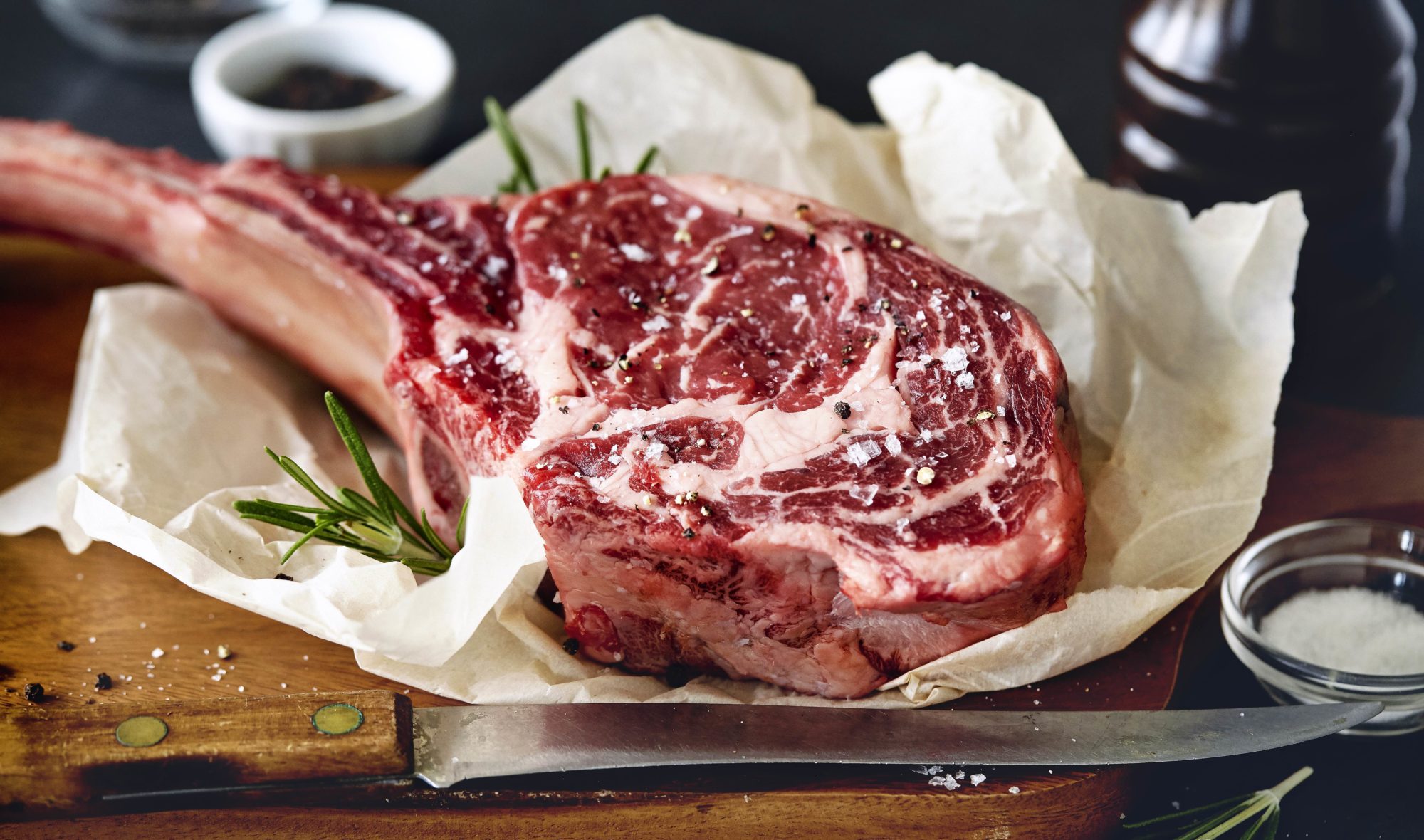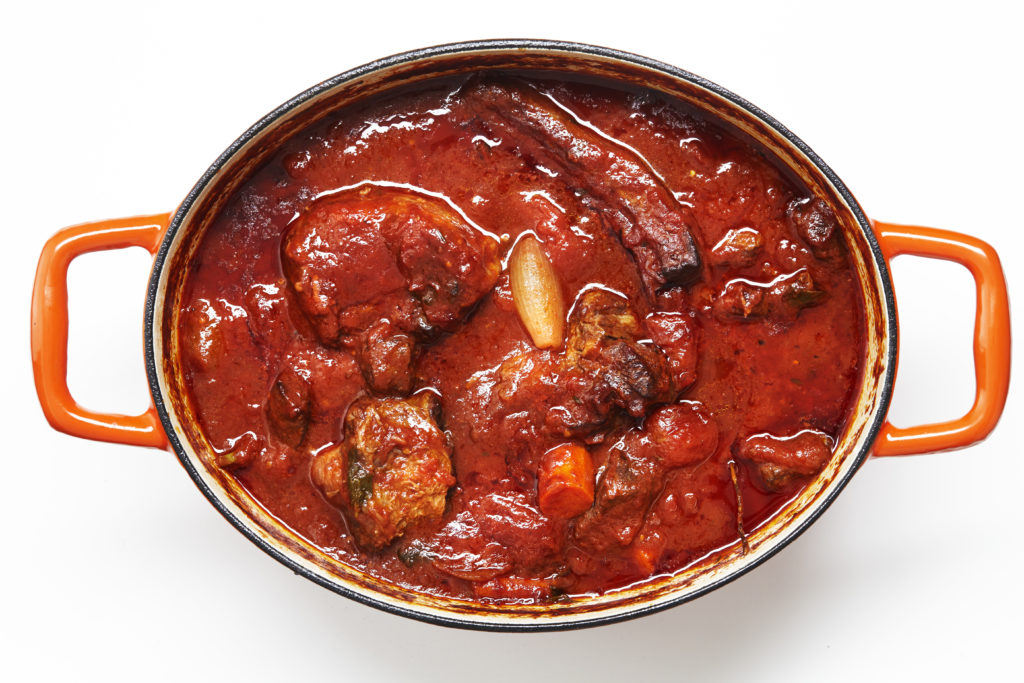
Beef refers to the meat that comes from the cattle animal. While beef offers many cuts, the meat is commonly enjoyed in the form of steak, ground meat (hamburger), or long-cooking roasts. Beef is an excellent source of protein, as well as zinc, iron, and B vitamins. For the most nutritious, best-quality meat, buy from a butcher or farmer. Store your meat in an airtight container in the refrigerator or freezer. For safety reasons, the USDA recommends cooking beef to 145°F.
Beef refers to the meat that comes from the cattle animal.
Cattle are farmed throughout the US and Canada, but the majority of cattle farming takes place in the American Central Plains and parts of the Midwest. In Canada, beef cattle are farmed in the Prairie Provinces (especially Alberta), as well as Ontario and Quebec.
Most people are probably familiar with Angus beef, though there a number of other varieties. Some of the most popular breeds of beef cattle in the US include Hereford, Gelbvieh, Limousin, and Simmental, though there are others.
A standard diet for conventionally-raised beef cattle is largely corn-based (though in Western Canada, barley is commonly used instead of corn). Some amount of forage (grass, silage or legumes) is usually included in this diet. Alternatively, pastured or “grass fed” beef cattle graze on grass.
Beef cuts
Beef offers numerous cuts for popular consumption.
Preferred (and more expensive) cuts typically come from the rib, loin, and sirloin. These cuts of meat come from the top to midsection of the animal’s body, so they are less muscular and therefore more tender than other cuts.
Rib cuts include prime rib, rib eye, cote de boef, and bone-in rib steak.
Loin and sirloin cuts include striploin, tenderloin, sirloin steak, sirloin roast, and T-bone steak.
The lower, belly area of the animal is where plate and flank cuts come from: these are usually eaten as steaks, such as bavette, flank steak, skirt steak, and hangar steak. These cuts can be slightly tougher (which can be offset by proper cooking and cutting), but offer a desirable rich, beefy flavor.
Longer-cooking cuts tend to be tougher but have plenty of flavor if prepared properly. These include:
In addition to these cuts, beef offers other edible ‘variety meats’ including:
These cuts are less popular in the Western diet, but they are embraced by some cultures, frugal cooks, adventurous eaters, and chefs. Those who embrace these more unusual cuts praise them for exceptional taste and nutritional value.
Ground beef is perhaps the most common form of beef. Of course, it forms what might just be America’s favorite food: the hamburger. Ground beef is also used in many other popular American dishes, including spaghetti with meat sauce, chili, meatloaf, and more.
Ground beef can come from various parts of the animal, but chuck is ideal as it offers a good balance of meat, fat, and rich flavor.
Though it varies slightly by cut, raw beef is typically a deep red color, which may appear somewhat purple, brown, or blue. Beef cuts that contain fat may have white “marbeling” throughout them – meaning you can see the lines of fat cutting through the meat.
Cooked beef should be somewhere on the spectrum of reddish-brown in color. For example, fully cooked ground beef will look brown, but over-cooked meat may appear grey in color.
In general, here’s how a steak should look when cooked, according to typical guidelines:
Three ounces of pan-browned lean ground beef (with a fat content of 15%) contains: 218 calories, 23.6g of protein, and 13.0g of fat.
Ground beef is an excellent source of zinc, iron, and B vitamins including B12 and B3.
Many cuts of beef can be purchased fresh from the meat department of your grocery store. Your grocery store may also have some beef available frozen.
One of the best ways to get quality meat – and to get more information about the beef, its origin, and how to prepare it – is to buy from a local butcher.
When buying meat, here are some things to check for:
Beef should be stored in the refrigerator and cooked before its expiry date. If you’ve purchased meat from a butcher and it’s wrapped in paper (not thoroughly sealed) you may want to put the package in a freezer bag to keep it fresh.
If you won’t be eating the meat within a couple days (or before the expiry date), you can freeze it to extend its lifespan. Generally, meat in the freezer will be good for a couple of months. Make sure it is wrapped in a tightly sealed heavy-duty freezer bag to avoid freezer burn.
Once cooked, beef will last about 4-5 days in a sealed container in the fridge.
Remember that frozen meat, once defrosted, cannot be re-frozen.
Beef preparation depends greatly on the cut, the recipe, and your personal preference.
In general, tender cuts require less cooking time: steaks, for example, can be seared in a skillet and then broiled until desired doneness.
Tough, hardy cuts such as beef brisket are best cooked ‘low and slow’ so they have time to become tender.
Ground beef requires little preparation. It’s quick and easy to cook and can be added to a variety of different dishes, making it a common favorite.
To cook ground beef, heat 1 tbsp of olive oil in a sauté pan at medium-high heat. When the pan is hot, add the beef, and use a spatula to quickly break the meat up in the pan so that it doesn’t stick together. Stir it occasionally. Once the meat has been seared you should see some dark brown (but not black) carmelization occurring. At this point, turn the heat to medium-low and continue cooking until the meat is thoroughly cooked – it should all be brown colored, not pink.
A note about safety: The USDA recommends cooking beef until 145°F for safety reasons. This recommendation is especially important for ground beef. When preparing meat, remember to wash your hands and all other cooking surfaces and utensils after they have touched raw meat.

This dish is a showstopper. Rich and hearty, save it for a lazy winter Sunday dinner with friends and family. It goes perfectly with roasted vegetables or over polenta. And don’t forget the vino!
Prep Time: 30 minutes Cook Time: 180 minutes Yield: 6 servings
Set a large dutch oven or stock pot over high heat. Season the beef with kosher salt, and add the oil to the pan. Once the oil is hot (but not burning) add the beef in a single layer. Sear the beef, browning on all sides. Remove the beef to a plate or tray. Add the carrots, onions, garlic and herbs, and stir. Deglaze the pot with the wine, cook for a minute or two and add the beef and any drippings back to the pot. Add the tomatoes and bring up to a slow simmer. Turn the heat down to medium-low. Every 15 minutes or so, remove the scum and fat that rises to surface, using a ladle or a spoon. Cook uncovered for about 3 hours, or until the meat is starting to fall apart, and the sauce is rich and thick. Remove from heat and let rest for 10 minutes. Garnish with parmesan shavings and ripped basil leaves.
Store leftovers in fridge.
Enjoy!
Precision Nutrition’s Encyclopedia of Food expands every single month as we highlight new foods and showcase beautiful food photography. If you’d like to stay up to date, simply click this link. From there, we’ll send you a FREE copy of our recipe book. We’ll also let you know when new and delicious foods are added to the site.
Beef refers to the meat that comes from the cattle animal. While beef offers many cuts, the meat is commonly enjoyed in the form of steak, ground meat (hamburger), or long-cooking roasts. Beef is an excellent source of protein, as well as zinc, iron, and B vitamins. For the most nutritious, best-quality meat, buy from a butcher or farmer. Store your meat in an airtight container in the refrigerator or freezer. For safety reasons, the USDA recommends cooking beef to 145°F.